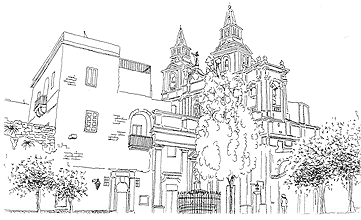
|
Mellieha is a rural village and tourist resort in the Northwestern part of Malta and derives its name from the Semitic root 'm-l-h' which in Arabic means salt. The name was probably derived from the ancient Punic and Roman salt-terns; historians indicated as lying adjacent to the large sandy bay at the foot of the village. |
 |
|
Mellieha has been inhabited since early Neolithic times (3000 B.C). Several megalithic remains and tombs of this era and other primitive tools and fragments of pottery were found in various localities around this area, primarily at "il-Latnija" - a natural cavity used by several stone-age peoples - and at l-Gholja tax-Xemxija. During the Roman and Byzantine occupations (213B.C- 870A.D.), Mellieha's valleys were inhabited by troglodytes, who irrigated the land, adopted natural caves as their dwelling places and buried their beloved ones in Punic style burial chambers. Following the Arab conquest and during the medieval period (870-1530A.D.), the area was deserted, primarily due to the continuous raids of the Muslim corsairs. Notwithstanding the hardship experienced by the Maltese during the Reign of the Order of St. John (1530-1798A.D.), Mellieha's medieval chapel, dedicated to the Holy Virgin Mary, was one of the most venerated places on the island. Several distinguished persons, such as grandmaster's, kings and bishops visited the shrine and pilgrimages to the sanctuary from all over the island were held frequently. In the late 17th century, the Knights built several fortifications along the coast, so as to protect the inhabitants. This venture brought about the gradual repopulating of the area, mainly by those who wanted to exploit the fertile valleys and the new enterprise of tunny net fishing. Under the British, in 1844, Mellieha was established again as a parish and since then it grew up into a modern town, of circa 6,500 people. Today, Mellieha is one of Malta's most picturesque tourist destinations. The town centre boasts of its splendid hotels, fine restaurants and traditional cute shops. It has a unique primary school, a majestic baroque church (built in late 19th century) and various cultural organizations, including band clubs, sports clubs, an orchestra, various religious societies, a parish community centre and an environmental pressure group. Since 1993, local affairs are being run by the Mellieha Local Council, an institution made up of seven councilors, elected every three years by the people. Mellieha's main festive season occurs in the first two weeks of September and reaches its climax on the 8th September. During these days various cultural manifestations are held, such as musical concerts, fireworks, folk singing, art exhibitions and the traditional religious procession. The town's people, ''Il-Mellehin'', are renowned for their laborious nature, their ironic sense of humour, and their friendliness and hospitality. Those who visit us, no matter where they hail from, do not merely enjoy themselves but feel at home. As long as Mellieha preserves its great archaeological and historic heritage, its unique natural environment, and its traditions and costumes, its people, "Il-Mellehin", can look forward to a bright future. |
||
| David Muscat | ||
| (For further information please contact dmusc@waldonet.net.mt) | ||

Maltaserv Bannerlink
